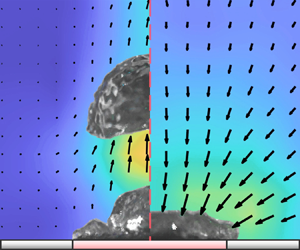Crossref Citations
This article has been cited by the following publications. This list is generated based on data provided by
Crossref.
Liu, Yanyang
and
Luo, Jing
2023.
Experimental study on damage mechanism of blood vessel by cavitation bubbles.
Ultrasonics Sonochemistry,
Vol. 99,
Issue. ,
p.
106562.
Tang, Jiguo
Hu, Rui
Xu, Lingmiao
Liu, Hongtao
and
Luo, Jing
2023.
Shape Oscillation-Induced Early Detachment of Bubble from a Submerged Microcapillary Nozzle.
Langmuir,
Vol. 39,
Issue. 46,
p.
16596.
Nam, Hyeon Taek
Cho, Hyung Hee
Lee, Seungro
and
Lee, Donghwi
2024.
Two-Phase Particle Image Velocimetry Visualization of Rewetting Flow on the Micropillar Interfacial Surface.
ACS Applied Materials & Interfaces,
Vol. 16,
Issue. 26,
p.
34313.
Luo, Jing
Xu, Lingmiao
Yao, Hongchi
Liu, Hongtao
and
Tang, Jiguo
2024.
Thermal convection in subcooled nucleate boiling and microbubble emission boiling: Insights from schlieren and chronophotography techniques.
International Journal of Heat and Mass Transfer,
Vol. 235,
Issue. ,
p.
126217.
Zhang, Zhongyao
Huang, Lifang
Xie, Hongzhao
Chen, Xiaopeng
Liang, Jiezhen
Wei, Xiaojie
Wu, Chenghong
and
Wang, Linlin
2024.
New insights into relationship between gas cavities with operating conditions and hydrodynamic characteristics in aerated stirred tanks: Integrated in-situ/DIP/ROIMI/BIV quantization and CFD simulation.
Separation and Purification Technology,
Vol. 340,
Issue. ,
p.
126706.
Liu, Luyao
Liu, Hongtao
Luo, Jing
and
Tang, Jiguo
2024.
Thermal-hydraulic performance of an imperfectly bonded ultrathin manifold micro pin-fin channel heat sink.
International Communications in Heat and Mass Transfer,
Vol. 156,
Issue. ,
p.
107684.
Xu, Lingmiao
Tang, Jiguo
Li, Xiao
Luo, Jing
and
Sun, Licheng
2024.
Towards understanding effects of ultrasonic waves on subcooled boiling using particle image velocimetry.
International Communications in Heat and Mass Transfer,
Vol. 156,
Issue. ,
p.
107711.
Huang, Haoxiang
Yu, Jialing
Yan, Zhe
and
Pan, Zhenhai
2024.
On interaction between a bubble with evaporation and heated pillar block in microchannel.
Physics of Fluids,
Vol. 36,
Issue. 3,
Otake, Akira
Kobayashi, Hotaka
Kurose, Kizuku
and
Ueno, Ichiro
2025.
High-frequency oscillation of coalesced vapor bubbles and resultant ambient liquid motion in microbubble emission boiling in subcooled pool.
International Journal of Heat and Mass Transfer,
Vol. 242,
Issue. ,
p.
126832.
Jamali, Bentolhoda
Behnia, Sohrab
and
Fathizadeh, Samira
2025.
Nonlinear bifurcation dynamics of laser-induced encapsulated microbubbles under acoustic cavitation: Influence of thermal and viscoelastic parameters.
Physics of Fluids,
Vol. 37,
Issue. 9,
Zhao, Qi
Lu, Mingxiang
Zhang, Yuanle
Li, Qiang
and
Chen, Xuemei
2025.
Flow microbubble emission boiling (MEB) in open microchannels for durable and efficient heat dissipation.
International Journal of Heat and Mass Transfer,
Vol. 238,
Issue. ,
p.
126506.
Lu, Jingyi
Xu, Haochen
Hu, Xianfeng
He, Yichuan
and
Tang, Dawei
2025.
Investigation on boiling heat transfer enhancement by hybrid thermal conductivity via lattice Boltzmann method.
International Communications in Heat and Mass Transfer,
Vol. 163,
Issue. ,
p.
108744.
Yao, Hongchi
Tao, Ye
Luo, Jing
Liu, Hongtao
Wang, Wenquan
and
Tang, Jiguo
2026.
Experimental investigation on the effect of oxidation on subcooled boiling under highly subcooled conditions.
International Journal of Heat and Mass Transfer,
Vol. 256,
Issue. ,
p.
127953.
Zhou, Jianhong
Zhang, Yuanle
Li, Qiang
and
Chen, Xuemei
2026.
Subcooled flow boiling in microchannels: Heat transfer enhancement via topology optimization and transient characteristics of microbubble emission.
International Journal of Heat and Mass Transfer,
Vol. 255,
Issue. ,
p.
127799.



